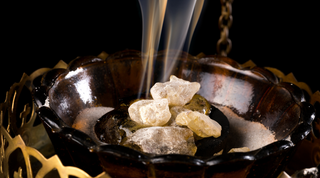The act of burning herbs is transformative. Burning loose herbs is a mood-boosting, aromatic experience unique to each person and it can be a powerful way to support your intentions. If you're new to burning loose herbs or resins though, the process might feel a little confusing. Here are some tips for getting started!
What you'll need for a successful burn:
- Firesafe container - use a filler such as ash, sand, rocks, etc. Examples: cast iron cauldron, brass bowl, fire pit, ceramic pot, large shell, etc.
- Consistent heat source - consider using hot charcoal, an electric/resin burner, or even an open flame.
- Tongs & Spoon - never use your hands!
- Snuffing agent - don’t leave a fire unattended. Use the container lid, sand, water, or dirt to extinguish your herbs when ready.
- Herbs and/or Resin of your choice (see list of ideas below) or shop the Apothecary.
How to burn incense using charcoal briquettes (our preferred method):
- Select and gather the herb(s) or resin you would like to use to support your intention.
- Select fire safe container
- Light coal. Use tongs to handle coal at all times!
- Place coal in the container. Coal is ready when it appears red or orange in color.
- Add your herbs. A little goes a long way. You can always add more herbs if desired.
- Clean your coal. Use the tongs to scrape away any accumulated herbs or ash from the coal.
- Allow the aromatic benefits to align you with your intention. Bask in it for as long as desired.
- Snuff out. Fully smother any burning embers before completing your burn.
- A note about Leftover herbs: Avoid disposing of remaining herbs in pipes and drains as they will clog over time. Consider burying them instead. Only handle remaining herbs once they have fully cooled.
Loose incense examples with corresponding intentions:
- Grounding - lemongrass, rosemary, juniper berry
- Protection - angelica root, rose petal, copal resin
- Meditation - calendula, lavender, chamomile
- Divination - mugwort, damiana, star anise
- Cleansing - cedar tips, eucalyptus, spearmint
*note: you can use herbs singularly or in combination. This is not an exhaustive list. Rosemary can be substituted for any herb!
.
While learning we recommend you utilize one of the herbal books linked below or focus on the herbs known to be safe in our listed examples. Some herbs may smell foul while others will emit toxic smoke. Please note, that some cultural uses of herbs belong to closed practices.
DISCLAIMER
Never leave burning embers or fire unattended.
Container will become hot. Allow to fully cool before handling.
Do Not directly inhale smoke from burning herbs. Do not burn in direct contact with small children and
animals. Please note, that item definitions can vary among traditions. If you are working within a formal lineage, we recommend working with a mentor.
While herbs can impact our experience of day-to-day life, they are not a substitution for
medical treatment. If you are experiencing a medical emergency, seek medical attention immediately.
.
RECOMMENDED READING MATERIAL
“Cunningham’s Encyclopedia of Magical Herbs” by Scott Cunningham
“The Magic of Herbs” by David Conway
“The Herbal Alchemists’ Handbook: A Complete Guide to Magickal Herbs & How to Use Them” by
Karen Harrison
“Entering Hekate’s Garden” by Cindi Brannon
“Sticks, Stones, Roots & Bones: Hoodoo Mojo and Conjuring with Herbs” by Stephanie Rose Bird
“Magical Folkhealing” by DJ Conway
Blog Post Written by Bash Quesenberry

